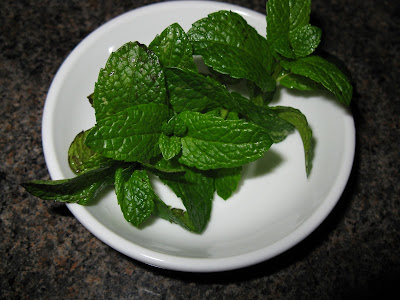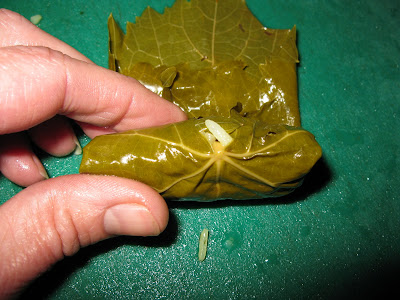(Um, speaking of taking liberties, watch this space -- we're cookin' up some serious Fusion Confusion in the next few weeks!)
Stuffed Grape Leaves, or Vine Leaves, as they are oftern called, are common in all Middle Eastern cultures. Recipes vary somewhat, as do names. Most frequently they are called dolmas or dolmadas, but I beleive that dolmathakia is the correct Greek word. I have also seen them referred to as Yaprak or Yalangi, as well as Warak Einab. All of the recipes include rice, but what goes in the rice can vary. There are usually some herbs, most commonly mint.
I like to add toasted pine-nuts, for a bit of crunch and extra favor. Many versions are vegetarian, but some do include ground lamb (lamb is very common in Middle Eastern cuisines) or ground beef. I followed My Own Famous Grape Leaves from AR. I made the rice one evening, intending to stuff the leaves the following day, but the rice was so good, The Man, a true rice freak, got stuck into it and we just had to have it for dinner! I will make rice this way again, just for the rice! As the recipe states, I chopped an onion and put it in a sauce pan with some oil, added the rice and stirred it over heat for about 5 minutes, or until the onion was clear. Then, I added some fresh mint and dry dill tips. Instead of chicken stock, I used vegetable stock, put the lid on the pot and let it simmer/steam for 15 minutes. I lightly toasted some pine nuts and mixed them in with the warm rice later.
But, ALL Dolmadas recipes start with the Grape Leaf itself. Grape vines grow well and commonly in the warm climate of the Mediterranean and Middle East, and I would imagine, that like so many evolving cultures, they were looking for ways to use anything at hand. Grape leaves in their natural state are rather tough, but young leaves that have been blanched and brined become more tender and supple. I usually buy mine in the jar, but any industrious sort (you know, the kind that likes to hang-out on AR) could (and would, just because she can) certainly try to blanch/pickle/marinate/smoke/re-boil/re-pickle their own!!!

Being less industrious, I buy mine...

First, carefully remove a wad of leaves from the jar and unroll/unfold them. Spread out a leaf, shiny side down on your work surface. The leaf will usually have a bit of stem still attached and you should snip it off.

Turn the leaf so the stem side is closest to you on your work surface, and put a spoonful of the rice next to the stem.
Press the sides of the leaf snuggly against the back of the rice ball, to form a log shape, and gently, yet firmly roll up the log to the end of the leaf.
Cover the dolmadas with just enough water to cover (some recipes call for topping the dolmadas with slices of lemon, or even rhubarb, at this stage) and simmer/steam for about 50 minutes.
Dolmadas usually are just one item found on a Middle Eastern mezze platter. The mezze is the appetizer or starter course. It can be small, large or huge! It always includes a delicious assortment of finger foods: dolmadas, pita bread with dips such as hummus and babaganoush (roasted eggplant dip), possibly feta cheese, kibbeh (small cigar shaped meatballs made from lamb) and olives. Depending on the culture, the dolmadas are usually served with some sort of minted yoghurt dip, either a garlic-y Greek Tsaziki or a lemony, minted yoghurt.
Place the dolmada in a large pot, and continue, continue, contine until the pot is full (or, the jar is empty!!!
Cover the dolmadas with just enough water to cover (some recipes call for topping the dolmadas with slices of lemon, or even rhubarb, at this stage) and simmer/steam for about 50 minutes.
Dolmadas usually are just one item found on a Middle Eastern mezze platter. The mezze is the appetizer or starter course. It can be small, large or huge! It always includes a delicious assortment of finger foods: dolmadas, pita bread with dips such as hummus and babaganoush (roasted eggplant dip), possibly feta cheese, kibbeh (small cigar shaped meatballs made from lamb) and olives. Depending on the culture, the dolmadas are usually served with some sort of minted yoghurt dip, either a garlic-y Greek Tsaziki or a lemony, minted yoghurt.
So, next time you need a good but possibly slightly exotic finger food, why not roll up some grape leaves?





No comments:
Post a Comment